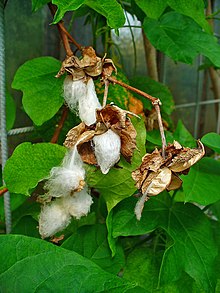Gossypium herbaceum
| Gossypium herbaceum | |
|---|---|
 |
|
| Scientific classification | |
| Kingdom: | Plantae |
| (unranked): | Angiosperms |
| (unranked): | Eudicots |
| (unranked): | Rosids |
| Order: | Malvales |
| Family: | Malvaceae |
| Genus: | Gossypium |
| Species: | G. herbaceum |
| Binomial name | |
|
Gossypium herbaceum L. |
|
| Synonyms | |
|
|
|
Gossypium herbaceum, commonly known as Levant cotton, is a species of cotton native to the semi-arid regions of sub-Saharan Africa and Arabia where it still grows in the wild as a perennial shrub. It is a sister-species of Gossypium arboreum.
G. herbaceum has high stems that grow 2 feet (0.61 m) to 6 feet (1.8 m) high with wide, hairy leaves. Their flowers are small and yellow with a purple center. When ripe and in warm weather, the flower capsule will burst and expose the cotton surrounding the seeds firmly. The cotton produced by this plant is short, about 2 inches (5.1 cm) long and is firmly attached to the seed, which is covered in hairy down. An acre of cotton can be expected to produce about 300 pounds (140 kg).
Cotton is usually used as a textile while making clothing and can be made into yarns and sheets of fabric. In the Levant seeds are often used for food. It is utilized so often because of its comfortable, breathable properties. It has been cultivated for women's menstrual cycle pains and irregular bleeding, and it also has been used after birth to expel placenta afterbirth and to increase lactation. Cotton has been used for gastrointestinal issues also, such as hemorrhages, nausea, and diarrhea, as well as fevers and headaches, especially in the southern United States. Gossypol, extracted from cotton seed, also has a potential use as a male contraceptive but can cause infertility after discontinuing. In lab rat studies, it has been able to stop pregnancies early.
...
Wikipedia
